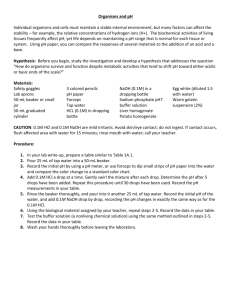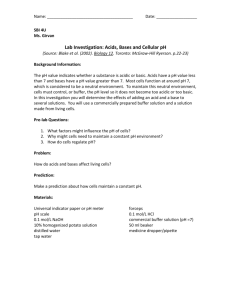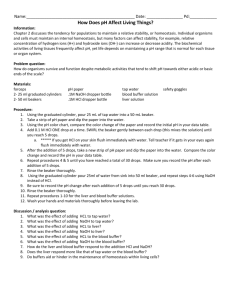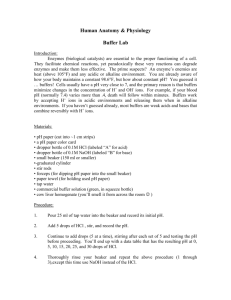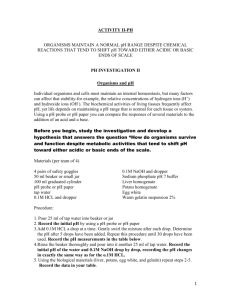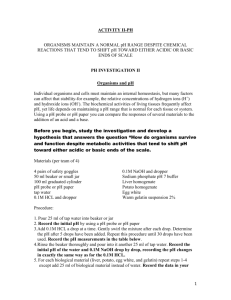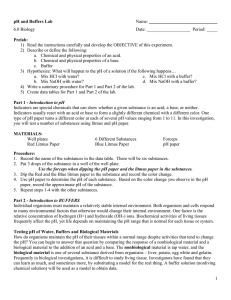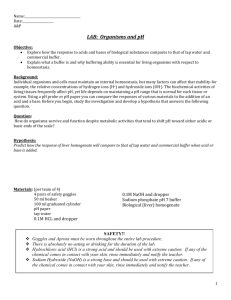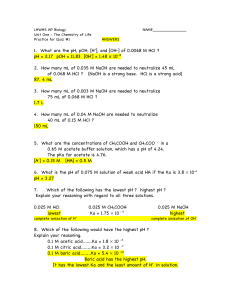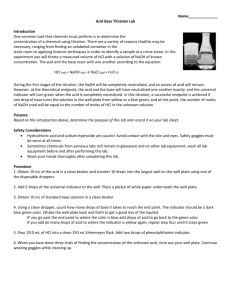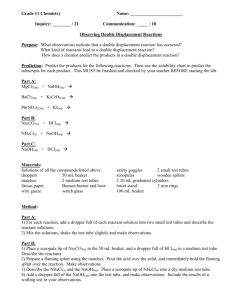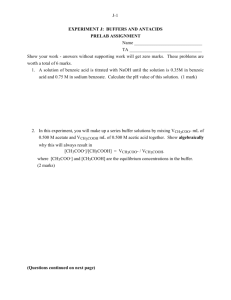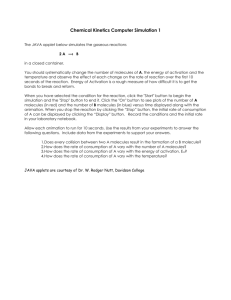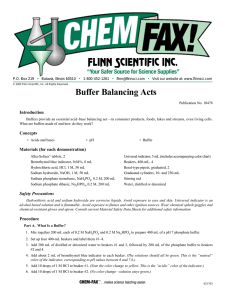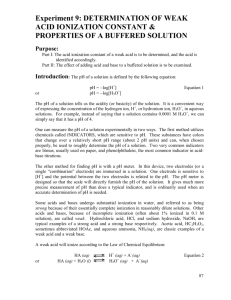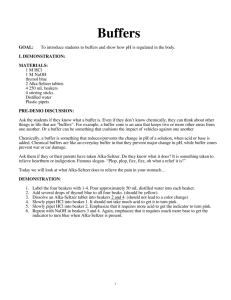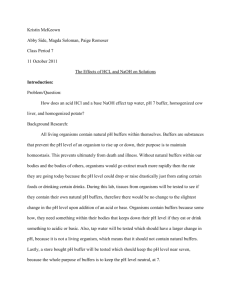Lab: Testing pH of Water and Biological Materials
advertisement
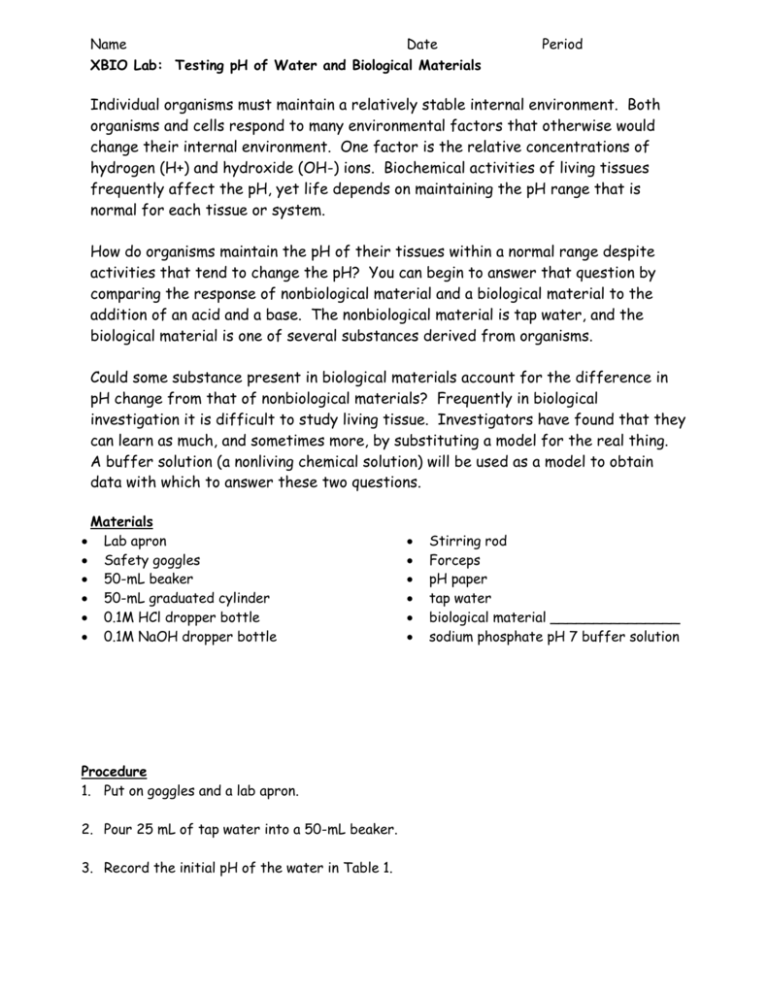
Name Date Period XBIO Lab: Testing pH of Water and Biological Materials Individual organisms must maintain a relatively stable internal environment. Both organisms and cells respond to many environmental factors that otherwise would change their internal environment. One factor is the relative concentrations of hydrogen (H+) and hydroxide (OH-) ions. Biochemical activities of living tissues frequently affect the pH, yet life depends on maintaining the pH range that is normal for each tissue or system. How do organisms maintain the pH of their tissues within a normal range despite activities that tend to change the pH? You can begin to answer that question by comparing the response of nonbiological material and a biological material to the addition of an acid and a base. The nonbiological material is tap water, and the biological material is one of several substances derived from organisms. Could some substance present in biological materials account for the difference in pH change from that of nonbiological materials? Frequently in biological investigation it is difficult to study living tissue. Investigators have found that they can learn as much, and sometimes more, by substituting a model for the real thing. A buffer solution (a nonliving chemical solution) will be used as a model to obtain data with which to answer these two questions. Materials Lab apron Safety goggles 50-mL beaker 50-mL graduated cylinder 0.1M HCl dropper bottle 0.1M NaOH dropper bottle Procedure 1. Put on goggles and a lab apron. 2. Pour 25 mL of tap water into a 50-mL beaker. 3. Record the initial pH of the water in Table 1. Stirring rod Forceps pH paper tap water biological material _______________ sodium phosphate pH 7 buffer solution 4. ACID GROUP: Add 0.1M hydrochloric acid (HCl) a drop at a time, swirling to mix after each drop. Determine the pH after each series of 5 drops has been added until 30 drops have been used. Record the pH measurements in the table after each 5 drops in Table 1. BASE GROUP: Add 0.1M sodium hydroxide (NaOH) a drop at a time, swirling to mix after each drop. Determine the pH after each series of 5 drops has been added until 30 drops have been used. Record the pH measurements in the table after each 5 drops in Table 1. CAUTION: 0.1M HCl and 0.1M NaOH are irritants and may destroy clothing. Avoid skin/eye contact; do not ingest. Immediately flush spills and splashes with water & call teacher. 5. Rinse the beaker thoroughly and pour in another 25 mL of the biological material into the beaker. Record the initial pH of the biological material in Table 1. Repeat step 4 (make sure you use HCl if you are in the ACID GROUP and NaOH if you are in the BASE GROUP). 6. Rinse the beaker thoroughly and pour in 25 mL of the buffer solution. Record the initial pH in Table 1. Repeat step 4. 7. If you are in the ACID GROUP share your answers with the BASE GROUP (and vice versa). 8. Return your materials to the appropriate location and wash your hands thoroughly before leaving the lab. Name Date Period XBIO Lab: Testing pH of Water and Biological Materials Data Table 1 Tests with 0.1M HCl pH after addition of Solution Tested 0 5 10 15 20 25 Tests with 0.1M NaOH pH after addition of 30 pH ∆ 0 5 10 15 20 25 Tap Water Buffer Bio Mat Analysis 1. Create ONE graph that includes… (make acid line straight and base line dashed) Water + acid Blue Legend: Water + base Buffer + acid Red Buffer + base Biological material + acid Green Biological material + base 30 pH ∆ 2. Summarize your graph in words. Conclusions 1. Write a hypothesis that the original experimenters were trying to test. 2. What is/are the control groups? 3. What is/are the experimental groups? 4. Summarize the effects of HCl on tap water. Summarize the effects of NaOH on tap water. 5. How do biological materials respond to changes in pH? 6. With respect to changes in pH, is the response of the biological material more like that of water or of the buffer? Justify your answer with data from the lab. 7. Would buffers help or hinder your body trying to maintain homeostasis if it was exposed to a strong acid or base? Explain you answer.
